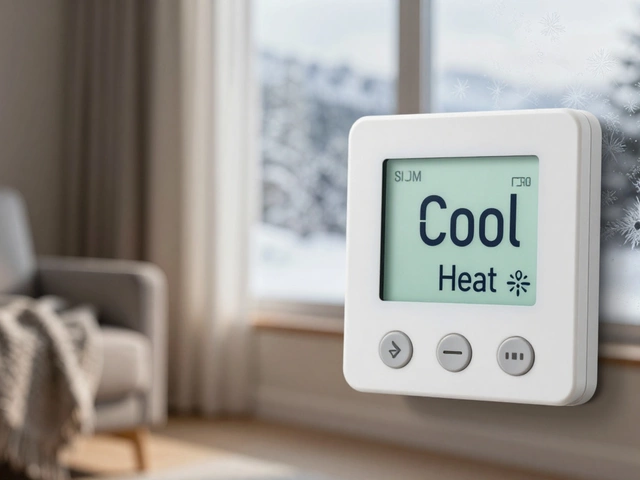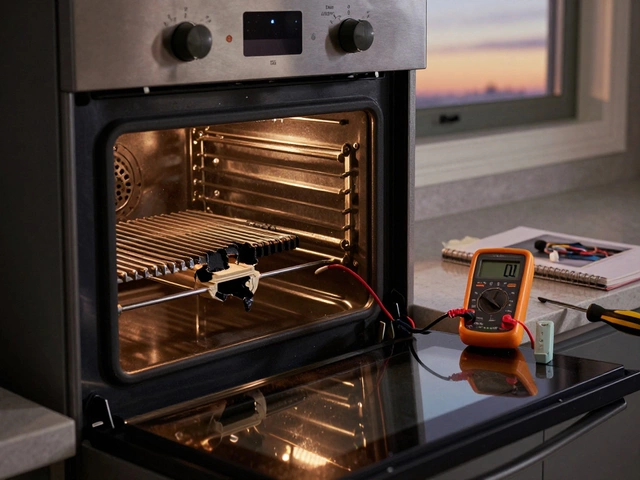Replacing an electric oven isn’t as scary as it sounds - but it’s not just a matter of unplugging the old one and plugging in the new. If you’ve never done it before, the process can feel overwhelming. You’re dealing with high voltage, heavy weight, precise measurements, and strict safety codes. But if you’re handy with basic tools and willing to take your time, you can do it yourself and save hundreds on labor costs. In Auckland, where homes often have older electric ovens dating back to the 2000s, many people are upgrading to newer, more efficient models. So, is it hard? Let’s break it down.
What You’re Really Up Against
The biggest hurdle isn’t the oven itself - it’s the electrical setup. Most electric ovens in New Zealand run on 240 volts and require a dedicated circuit. That means you can’t just plug it into a regular power point. If your old oven was hardwired (which most are), you’ll need to disconnect live wires inside the wall or cabinet. That’s not something you do with a screwdriver and a prayer.
Also, electric ovens are heavy. A standard 60cm model weighs between 45 and 65 kilograms. If you’re working alone, you’ll need a dolly or a helper. One wrong move while sliding it out - especially if it’s mounted under a countertop - and you could damage your cabinetry, floor, or worse, your back.
Then there’s the fit. Not all ovens are created equal. Your new oven might be slightly wider, deeper, or taller than the old one. If the cutout in your kitchen doesn’t match, you’ll need to modify the cabinetry. That’s where things get messy. You don’t want to cut too much and end up with a wobbly oven that doesn’t seal properly.
Step-by-Step: How to Replace an Electric Oven
If you’ve decided to go ahead, here’s how to do it safely and correctly.
- Turn off the power. Go to your main switchboard and flip the breaker for the oven. Don’t just rely on the oven’s control panel being off. Use a non-contact voltage tester on the wires behind the oven to confirm no power is flowing.
- Remove the old oven. Open the oven door and locate the mounting screws - usually on the sides or underneath the frame. Unscrew them. If it’s hardwired, carefully disconnect the wiring. Take a photo of how the wires are connected before you unplug them. Label them if needed: Live (brown), Neutral (blue), Earth (green/yellow).
- Measure the cutout. Write down the width, height, and depth of the opening. Compare it to the specs of your new oven. If there’s a mismatch of more than 5mm, you’ll need to adjust the cabinetry. Use a measuring tape, not your eyes.
- Prepare the new oven. Remove all packaging, including any protective foam or plastic inside the oven cavity. Check for damage. If the door doesn’t close properly or the glass is cracked, return it now.
- Slide in the new oven. Use a dolly or get help. Position it so the leveling legs are just above the floor. Push it gently into the opening. Don’t force it.
- Level the oven. Use a spirit level. Adjust the front legs until the oven is perfectly level both front-to-back and side-to-side. An unlevel oven can cause uneven cooking and door seal leaks.
- Connect the wiring. If you’re hardwiring, connect the wires the same way as the old oven. Use wire nuts or terminal blocks rated for 240V. Never leave bare wires exposed. If your new oven has a plug, make sure the outlet is the correct type (usually a 15A or 20A dedicated socket).
- Secure the oven. Reattach the mounting brackets. Close the door and check for gaps. If the door doesn’t seal evenly, the oven won’t heat properly.
- Restore power and test. Turn the breaker back on. Set the oven to 180°C and let it run for 20 minutes. Check for unusual smells, noises, or flickering lights. If anything feels off, turn it off and call a professional.
When You Shouldn’t Do It Yourself
There are clear signs you need to hire a licensed electrician:
- Your home’s wiring is older than 20 years and hasn’t been upgraded.
- The breaker trips every time you turn on the oven.
- You don’t know how to read a wiring diagram.
- The oven is in a rental property - landlord rules often require licensed tradespeople.
- You’re replacing a built-in oven with a freestanding one and need to move plumbing or gas lines (yes, even electric ovens sometimes share space with gas cooktops).
In New Zealand, electrical work on fixed appliances like ovens is regulated under the Electrical (Safety) Regulations 2010. If you do it wrong and cause a fire, your home insurance might not cover it. That’s not a risk worth taking.

Costs: DIY vs Professional
Let’s talk money. A basic electric oven in New Zealand costs between $600 and $1,500. Installation by a licensed electrician typically runs $200-$400, depending on your location and complexity. In Auckland, prices are on the higher end due to labor rates.
If you do it yourself, you save the labor cost - but you’re also responsible for any mistakes. A miswired oven can fry your control board, ruin your kitchen, or start a fire. That’s not a $200 problem - that’s a $5,000 problem.
Here’s a quick comparison:
| Item | DIY Cost | Professional Cost |
|---|---|---|
| Oven (mid-range) | $900 | $900 |
| Tools (dolly, tester, screwdrivers) | $100 (one-time) | $0 |
| Electrician labor | $0 | $300 |
| Wiring upgrades (if needed) | $0 | $200-$800 |
| Risk of damage/mistakes | $0-$2,000+ | $0 |
DIY looks cheaper on paper - but only if everything goes perfectly. For most people, the peace of mind and guaranteed safety of hiring a professional is worth the extra cost.
What to Look for in a New Electric Oven
Not all ovens are created equal. Here’s what matters most:
- Size and fit: Stick to standard dimensions unless you’re doing a full kitchen remodel. 60cm wide is the most common.
- Power rating: Most ovens draw 2.5-3.5 kW. Make sure your circuit can handle it. Older homes often have 10A circuits - that’s not enough.
- Self-cleaning: Pyrolytic cleaning is great but uses a lot of energy. Steam cleaning is gentler and cheaper to run.
- Convection: Fans inside the oven circulate heat. It’s worth the extra $100-$200 for even baking.
- Brand reliability: Brands like Bosch, Miele, and Smeg have better long-term support in New Zealand. Avoid no-name brands - parts and repairs are hard to find.

Common Mistakes People Make
Here’s what goes wrong when people try this themselves:
- Forgetting to turn off the main breaker - and getting shocked.
- Using the wrong wire nuts - causing overheating and melting.
- Not leveling the oven - leading to door seal leaks and uneven cooking.
- Ignoring the ventilation gap - ovens need at least 10mm of space on all sides to breathe.
- Trying to use a regular power outlet - electric ovens need a dedicated circuit, not a shared one.
One Auckland homeowner tried to plug a new oven into a 10A kitchen outlet. The breaker tripped every time he turned it on. He called an electrician, who found the circuit was overloaded and had to install a new 20A line - costing him $650. He could’ve saved that money by checking the specs first.
Final Verdict: Is It Hard?
Replacing an electric oven isn’t hard if you’re prepared. It’s physical, technical, and requires attention to detail. But if you’ve ever changed a light switch, tightened a faucet, or assembled IKEA furniture, you have the skills to do this.
Just don’t rush it. Take your time. Double-check the wiring. Level the oven. Test it slowly. And if you’re even a little unsure - call a professional. There’s no shame in hiring someone who does this every day.
Electric ovens last 10-15 years. If yours is older, it’s probably using twice the energy of a new model. Replacing it isn’t just about convenience - it’s about saving money on your power bill and making your kitchen safer.
Can I replace my electric oven myself?
Yes, if you’re comfortable working with electricity and have the right tools. You need to turn off the power, disconnect the wiring safely, measure the cutout, level the new oven, and reconnect everything correctly. If you’re unsure about any step - especially the wiring - hire a licensed electrician.
How much does it cost to replace an electric oven in New Zealand?
The oven itself costs $600-$1,500. Professional installation adds $200-$400. If your electrical system needs upgrading - like a new 20A circuit - that can add $200-$800. DIY saves labor but risks costly mistakes if done wrong.
Do I need a special outlet for an electric oven?
No special outlet - but you need a dedicated 240V circuit with a 15A or 20A breaker. Most electric ovens are hardwired directly into the wall, not plugged in. If your old oven was hardwired, the new one should be too. Never plug a built-in oven into a regular power point.
How do I know if my oven is hardwired?
Look behind the oven. If you see wires connected with terminal blocks or wire nuts instead of a plug, it’s hardwired. If you see a power cord ending in a plug, it’s a plug-in model - rare for built-in ovens. If you’re not sure, turn off the power and check with a voltage tester.
What if the new oven doesn’t fit the cutout?
Measure the cutout before buying. If the new oven is slightly larger, you can carefully trim the cabinet sides with a jigsaw. If it’s smaller, you’ll need to build out the opening with timber or filler panels. Never force a mismatched oven - it can damage the door seal or cause heat leaks.
How long does replacing an electric oven take?
If everything fits and the wiring is ready, it takes about 1.5 to 2 hours. If you need to adjust the cabinetry or upgrade the circuit, it can take 4-6 hours. Always allow extra time - rushing leads to mistakes.
Should I replace my 15-year-old electric oven?
Yes. Ovens older than 10-12 years are significantly less efficient. A 15-year-old model can use up to 40% more electricity than a new one. You’ll also face harder-to-find parts if it breaks. Newer models have better temperature control, safety features, and energy ratings.





